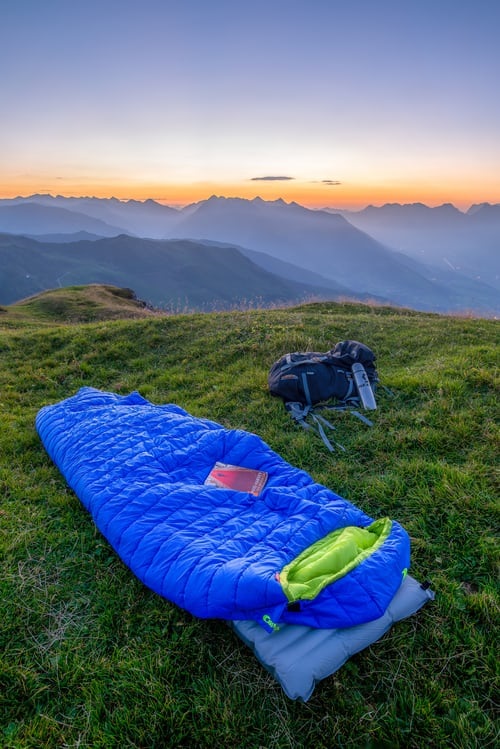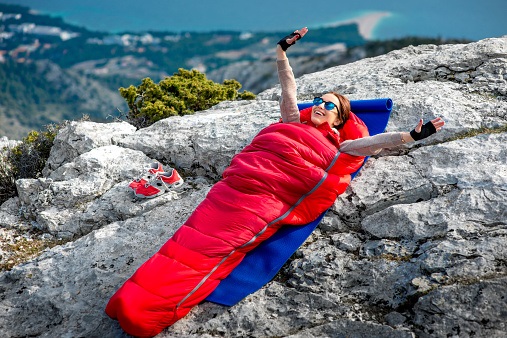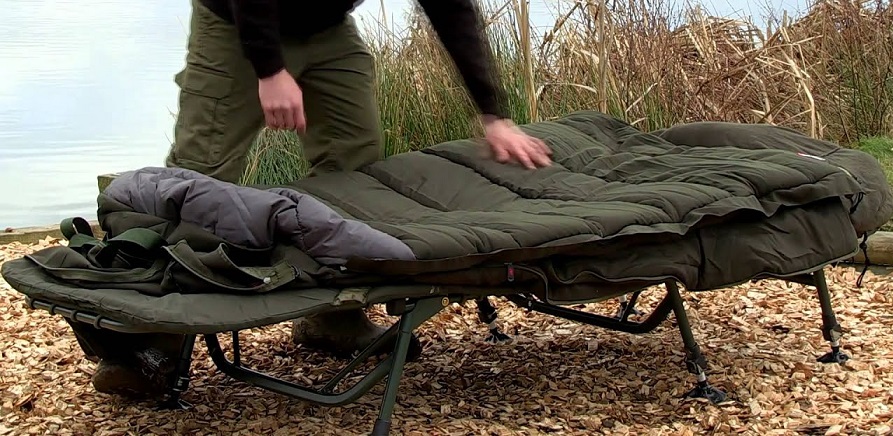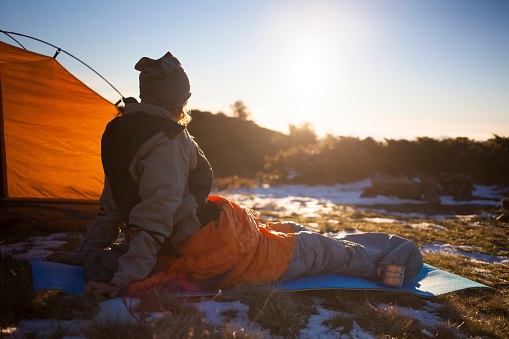Your sleeping bag is your savior, that allows you to rest well and regain the energy that you lost from a hard day’s travel or trek. So, it is necessary that you have a thorough understanding of the sleeping bag that you will buy. To assist you in being a smart buyer, we have got some tips for you. Read on.
Click Here To Know Different Types of Mattress
Sleeping Bag Features You Need to Know About
1. Types of Sleeping Bags
Sleeping bags are bifurcated in three categories – summer, three-season and winter.
-
Summer
Sleeping bags for summers have the capacity to bear temperature of about 30ºF and more. Usually these types of bags are lighter as they have less insulation, and so can be squeezed to a bare minimum and tucked in anywhere, be it your rucksack or bike’s basket.
Summer sleeping bags most of the time come with full-length zippers, that allows you to adjust the cover as per the temperature outside (open it completely for better ventilation or use it as a quilt). These sleeping bags most of the time are like simple sacks without too many bells or whistles. Also, many of them do not even have hoods, as quite naturally you will not want to cover yourself completely on a hot summer night.
-
Three-Season
Three season sleeping bags are ideal for temperature of 20ºF and above. They are the best for spring and post-monsoon seasons, and also if you are trekking on high mountains during summers, as the temperature tends to dip below freezing points during nights there.
While buying look a three season bag that has added feature like clinch-able hoods, draft collars, or zipper draft tubes to help you survive the cold.
-
Winter
Winter bags are usually puffy and best for temperatures of or below 20ºF. They will have all the features of a three-season sleeping bag, but the add on is more insulation.
The disadvantage of these bags is their heaviness. Hence, it is important that with a winter sleeping bag you also buy a compression stuff sack that will help you to stuff and carry it easily.
2. How The Temperature is Rated?
All sleeping bags have temperature ratings. The rating indicates minimum amount of temperature your sleeping bag is able to handle. Though, currently there is no set standard to determine the rating, which means the manufacturers have the unsaid freedom of making their own claim about the warming capacity of their products.
However, recently a new rating system has come-up in Europe called 13537. Even manufacturers in US have adopted this system. The ratings are based on the following parameters:
- Upper Limit: highest temperature that an average man can sleep in comfortably.
- Comfort: lowest temperature that an average woman can sleep in comfortably.
- Lower Limit: lowest air temperature that an average man can sleep in comfortably.
A heat-sensored mannequin is used to determine these ratings.
We suggest you to choose your sleeping bag based on this formula of temperature rating, at least until a standard formula is adopted worldwide.
3. Types of Insulation
A sleeping bag is only a fabric packet without its insulation. So, one of the major features that you need to look into is a sleeping bag’s insulation type. Now, also understand that each insulation type has its own pros and cons.
What you should be bothered about is the kind of camping that you will be doing. Here is what you need to know about the insulation types:
-
Down
The concept comes from mother nature’s way of insulation. Down that was inspired from under feathers found in ducks or geese, is the most efficient in keeping its user warm. But the catch is it is ideal only for dry places.
Though this is the most expensive form of insulation used for sleeping bags, but manufacturers don’t mind investing in it as there is good demand for quality sleeping bags in the market.
What you should know is that down is the lightest and most efficient insulation. It can also be compressed well, and it is able to retain its insulating power no matter how much it is squeezed. Down insulation is calculated as per its fill-power. The measurement of fill-power is derived based on the number of cubic inches one ounce of down consumes in a beaker. The fill power rating range from 600 to 900.
Also remember that when it comes to down insulation, the higher the number the warmer you will stay within the sleeping bag.
-
Synthetic
The best part about synthetic bags is that they dry fast, and hence are always good for rough and tough use. This type of insulation also keeps you warm; though will be less effective in case they are wet.
About synthetic insulation what you also need to know is their types. Most of the times they are fluffy polyester material that don’t absorb water, which is what a camper need.
Though they are bulky, but we would certainly recommend them over the down ones, for the simple reason that they can be used in dry as well as wet weathers.
-
Others
Insulation can also be done by multiple layer construction, extra fill in areas around the extreme corners of the sleeping bag, or in the highly compressed spaces, and additional shoulders and zippers is what will help you to stay warm in the coldest of surroundings.
Also, when there is a multiple layer insulation, it will help in evenly distributing the fill. Which means that the stuffing will not clog at the corners when they come under your weight. Multiple layers also provide more durability to the bags.
Benefits in Choosing the Right Insulation
- Helps in determining the general weight of the sleeping. You will also get fair idea about how heavy it can get when wet.
- The compression of your sleeping bag also depends on its insulation. For example, it would be easy to compress a synthetic insulation than a down or multi-layered one.
- Insulation becomes the deciding factor on whether or not you will be able to use the sleeping bag in a dry or wet weather.
- The durability of any product depends on what it’s got within it, and same is the case with a sleeping bag. The insulation types determine its level of durability.
- A sleeping bag that dries quickly is your only option for long treks. As you will be able to wash and dry them easily. Even that depends on the insulation of the bag.
- Not many check whether a sleeping bag insulates even while its wet. Do not that only synthetic insulation provide this benefit.
- If you have a sensitive skin, then you better be aware of the kind of insulation in your sleeping bag. Again it is usually synthetic insulation that is non-allergenic.
4. Choosing the Right Fabric
The only question you ask when looking at the fabric of your sleeping bag is – Do I need a waterproof sleeping bag or not?
Of course you will. Whether you camp with a tent or without it, your sleeping bag with a shell is required to save you. Not only snow clad mountains, or rainy areas, but a waterproof shell or fabric keeps you safe from the night’s fog as well.
Remember to check the fabric to be breathable as well. The fabric feels more like your rain jacket. If you choose a sleeping bag with a fabric that doesn’t provide breathable space, then forget about rain, you will be sleeping in your own sweat. Also, your waterproof bag needs to be seam-taped, so that the water doesn’t migrate inside the bag through the stich holes.
a) Types of Lining Fabrics
-
Nylon, Polyester and Taffeta
The most common types of fabrics are these – nylon, polyester and taffeta. They are breathable and comfortable. These materials are easy to procure, and hence they reduce the price of the sleeping bags for you.
Do note that a less expensive sleeping bag will have a nylon lining, and towards a higher side would be taffeta which is the best among the three.
-
Fleece
Fleece is a brushed lining that helps you to stay warm, in extreme colds. They are also very soft on the skin. But, the disadvantage is that fleece traps the heat and hence will cause a lot of discomfort if you are sleeping in a same spot for a longer time.
Most of the times you will find fleece linings used in rectangular sleeping bags that offer more room to shift your sleeping position.
-
Silk
Silk is the most ethnic material use for fabric lining. It is soft, supple and breathable. Silk does not trap the heat generated by your body either. You will find silk in expensive mummy styled sleeping bags with down insulation.
But, the downside of silk fabric lining is that it tears more easily than other liners, and irreparable.
-
Flannel or Cotton
Other than fleece you will also find flannel and cotton linings in rectangular sleeping bags. They are breathable, durable and lightweight materials, that can be easily cleaned.
But both of these materials trap moisture within them, hence can only be used in moderate or dry environments.
Though there is some good and some bad features in all these fabrics, but we would recommend nylon or polyester however, as they are breathable fabrics available at affordable rates.
b) Types of Shell Materials
Shell is the outer fabric used in making a sleeping bag. Like the fabric linings, even shell materials have their varieties, such as:
-
Nylon, Polyester, Taffeta
You will find these materials mostly in mummy sleeping bags. They are the best for car camping or general walk-in camping. These are breathable fabrics.
Also, remember that these materials help the sleeping bag in being water proof.
-
Ripstop
Ripstop belongs to the family of nylon and polyester, but with heavier threads woven into the material. Heavy threads help in reinforcing the shell, making it stronger and more resistant to rain tears and moistures. They too just like their polyester and nylon are breathable.
This shell fabric is considered best for three-season camping where the weather won’t be too damp.
-
DryClime, Microfiber, Gossamer Micro
There is one thing common among all these three kinds of materials – they are all tightly woven, strong and moisture-resistant. They are soft compared to Ripstop, and that is because they lack the heavier threads sewn into the material.
These are most apt material used for 3 season camping.
-
DryLoft
This fabric has water-resistant feature; it is very breathable which makes it an extremely comfortable material to lie on. The best part is that you will stay warm and dry on the inside, leaving the wetness and dampness of the weather outside. They are ideal for four-season camping, canoe camping and even backcountry camping.
But among all these we highly recommend Ripstop, as they are more durable.
5. Additional Features
Something extra always gives us the bend to choose a particular item or product. The same is the case while choosing a sleeping bag. Learning about this additional features will also help you to gage the standard of a sleeping bag.
6. Sleeping Bag Hood
Hood protects your head and offers that added warmth, especially when it is tucked in tightly around your head.
There are some hoods include “differentiated drawcords”, that have different thicknesses, for you to have a good idea about which cord is for neck fit and which one to use for adjusting the hood opening.
7. Draft-Blocking Features
Draft tubes run throughout the length of the bag, and are located right behind the zipper. They help in keeping the warm air from escaping. This is probably one the best features of a sleeping bag to be used for cold temperatures. Make sure you check for draft blocking while buying your bag.
8. Anti-snag Zipper Feature
Every time you try to close or open the zip of your sleeping bag snagging becomes an issue. To curb the problem some sleeping bag manufacturers shield the zipper with a guard that goes along with its full length. There are other types of bags in which the problem is solved through the cover of the zipper itself.
9. Stash Pocket
A stash pocket makes life easy. It is located on the chest near the top of the bag. It is handy in keeping small items such as lip balm, watch etc. safe and closer to your hand’s reach.
10. Sleeping Pad Compatibility
Sleeping pads are usually sold separately. They can be adjusted in a few bags whose underside insulation has been replaced with a sleeve to fit the pad.
While buying sleeping pads also look for pad loops that allow you to use straps to connect the bag to your pad.
11. Pillow Pocket
You will get this option is few sleeping bags. These pockets help you to stuff clothes inside, to create a pillow. But, if your bag does not have this feature, you can always either get a pillow from home or buy a camping pillow, separately.
12. Sleeping Bag Accessories
Some sleeping bags also come with accessories that makes it easy to fold and carry them. Like the stuff sack, storage sack, and sleeping bag liner.
You might get stuff sack along with the sleeping bags or may have to buy them separately. They help you to easily compress the bag for easy packing.
Many times too much compression does not allow the sleeping bag to loft or insulate properly. Storage sacks are handy in those times. They are large mesh of cotton storage sacks.
A soft sleeping bag liner helps in minimizing the wear of the bag. All you have to do is slip it inside your bag. It also helps in keeping your bag clean. Also, adding a liner can add up to its warmth, allowing it to suffice in wider variety of temperature.
How to be a Smart Sleeping Bag Buyer?
You cannot ensure the quality, comfort and durability of the sleeping bag just by check its features or by buying some additional accessories.
To buy a good sleeping bag you would need to try and test it well. Here are some smart tips for you to help you be a smart buyer:
1. Buy After you Try
Doesn’t matter how many sleeping bags you are trying. What you must do is crawl inside them, wearing enough layers of clothes, to get a real-time feel of the different types of sleeping bags.
2. Roll Around
Crawling won’t help. You need to also rotate your body to check the space.
3. Use the Sleeping Pad
If your sleeping bag comes with a sleeping pad, then integrate it and then check the size. Because, many times a pad reduces the bag’s interior volume, affecting its size and fit.
4. Check the Bag Closures
Zip the bag twice or thrice to check if it is snagging, or if the guards are working well or not. Also, snap the hood and draft the collar down to check the performance. Whether it’s a comfortable fit, your head is snugged up well inside, whether you feel a scrub on your cheek due to the fabric, and how easy is it to come out of the hood.
How to Wash Your Sleeping Bag?
- Manufacturer’s advice: check the label of the sleeping bag for any special instructions. Whatever we instructions we provide here, if they contradict with the manufacturer’s instructions, then go ahead with manufacturer’s advice.
- Close the Zippers: The second step would be closing the zippers and fasteners. Then turn the sleeping bag inside out, for the body oils on the interiors to wash off.
- Use the right soap: If your sleeping bag has down insulation then go for a mild soap that won’t strip oils from the feathers, such as Nikwax Down Wash or Revive Down Cleaner. You can be a buy Granger’s Extreme Cleaner Plus for synthetic insulation.
- Washing instructions: either hand-wash the bag in a tub or use a front-loader. If you use a top-loader, its agitator may tear the baffles. Also, go for gentle cycle in washing machine with cold water. After the washing is done, run an extra rinse or even two rinses to remove the soap.
- Post washing: Remove the bag carefully post washing. Support it from underneath to keep the waterlogged insulation from ripping out the stitches. Hang the bag lengthwise on a laundry line until the water weight is gone.
- Drying the sleeping bag: Use a commercial dryer. Place the sleeping bag in a large commercial dryer. Dry it on low heat and keep checking. In case of down sleeping bags, remove every 30 minutes to de-clump the feathers. Once the process is complete, leave you bag unstuffed for a few days. Use a cotton sack to store it or even a pillowcase.
Frequently Asked Questions
Sleeping bag is more like a lightweight quilt that can be closed with a zip. It looks more like an insulated tube protecting a person while they sleep outdoors.
Basically there are two parts in a sleeping bag. One is the bag itself, and the other is the sleeping pad. Look for a bag which when combined weighs maximum 2kg, not more than that.
Fold the sleeping bag in a classic style like a handkerchief or compress it. Do not roll or fold the bag, as first they will not fit-in the case, and second even if they do, you will compress the insulation more, gradually spoiling the insulation material.
Sleeping bag liners keep them clean and hygienic for use. You basically sleep on the liner; hence it becomes important to keep them clean. Bag liners are usually lightweight and easy to pack and they also add to the warmth of the sleeping bag.
Mummy sleeping bags are lighter compared to the others, making them ideal choice for backpacking. They also keep you warmer as the heat efficiency is not compromised because of its shape.
Yes, you can. To zip two sleeping bags you need to have rectangular bags. Open both the bags completely, unfold them to double the size. Lay one bag on top of the other, match the lining. Then zip the bags together from the middle of the foot of the bags, all the way round to the perimeter of the joined bags, and you will have a double wide sleeping bag ready.





